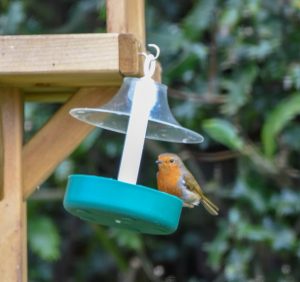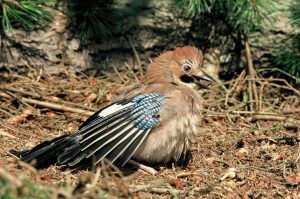A good time to feed live food
With the breeding season well and truly underway now, you might like to consider adding another ‘dish’ to the menu of foods on offer to the birds in your garden. The food in question is live and is more usually known as mealworms. If you do decide to offer these tempting morsels, the birds will certainly thank you, and you will probably be helping with the next generation of birds in your area.
Although you can feed live food all year round, it’s at nesting time that it’s felt to be particularly important. So with the birds busily building nests around the garden, I recently ramped up the amount of live food on offer, particularly with the weather being so cold, and have been rewarded by some eager recipients.
Live food is high in protein (50.4% to be exact) and, if you’ve not fed your birds with any in the past, you’ll find that it won’t take long before your resident tit family and Robins find this new dish on offer. You might be a little squeamish about handling mealworms, or the larvae of the Tenebrio Molitar beetle to be more precise, but they don’t smell and are clean and easy to handle so don’t be put off - your birds with thank you for it.
If you do decide to offer mealworms you will probably need to look at getting a proper feeder for them, one with high sides to stop any escapees, and one with some form of roof over it is also a good idea. Mealworms don’t take too kindly to rain, so try and shelter them as much as possible. I feed a little and often, in particularly wet weather, as it cuts down on waste and you can keep the feeder clean and dry.
If you’ve not bought live food before I suggest you start with smaller quantities which come packed in plastic tubs which can safely be stored at between 8-10ºc in a cool dark place. If you have a suitable shed or outdoor store, you may prefer to use these locations, but wherever you store, make sure they don’t freeze, so they need to be protected from frost. Once you are happy to feed mealworms you can then start to buy larger quantities to keep the flow of food going. If stored correctly they should last several weeks.
Some people question if feeding like this is a good idea, as it can have an impact on the uptake of naturally occurring food, but with the numbers of insects decreasing due to changes in our climate and habitat loss, my personal view is that it’s unlikely that the amount of food of this type you make available isn’t going to cause any major problems. After all, according to the BTO, a young Blue Tit needs 100 caterpillars a day to survive. You could argue that for each mealworm you provide stops another insect being taken from these dwindling numbers.
Depending on your local species, you could well find wagtails, Wrens, sparrows, starlings and nuthatches all visiting to enjoy what you have on offer for them. All species will be particularly grateful, not only during the breeding season, but also during the moult, feeding up in preparation for winter and, of course, while feeding fledglings. So if you really want to help the birds in your area, now is an ideal time to start feeding live food. I’m sure, like me, you’ll enjoy the benefits of doing so.
Images & content © Phil Pickin
Although you can feed live food all year round, it’s at nesting time that it’s felt to be particularly important. So with the birds busily building nests around the garden, I recently ramped up the amount of live food on offer, particularly with the weather being so cold, and have been rewarded by some eager recipients.
Live food is high in protein (50.4% to be exact) and, if you’ve not fed your birds with any in the past, you’ll find that it won’t take long before your resident tit family and Robins find this new dish on offer. You might be a little squeamish about handling mealworms, or the larvae of the Tenebrio Molitar beetle to be more precise, but they don’t smell and are clean and easy to handle so don’t be put off - your birds with thank you for it.
If you do decide to offer mealworms you will probably need to look at getting a proper feeder for them, one with high sides to stop any escapees, and one with some form of roof over it is also a good idea. Mealworms don’t take too kindly to rain, so try and shelter them as much as possible. I feed a little and often, in particularly wet weather, as it cuts down on waste and you can keep the feeder clean and dry.
If you’ve not bought live food before I suggest you start with smaller quantities which come packed in plastic tubs which can safely be stored at between 8-10ºc in a cool dark place. If you have a suitable shed or outdoor store, you may prefer to use these locations, but wherever you store, make sure they don’t freeze, so they need to be protected from frost. Once you are happy to feed mealworms you can then start to buy larger quantities to keep the flow of food going. If stored correctly they should last several weeks.
Some people question if feeding like this is a good idea, as it can have an impact on the uptake of naturally occurring food, but with the numbers of insects decreasing due to changes in our climate and habitat loss, my personal view is that it’s unlikely that the amount of food of this type you make available isn’t going to cause any major problems. After all, according to the BTO, a young Blue Tit needs 100 caterpillars a day to survive. You could argue that for each mealworm you provide stops another insect being taken from these dwindling numbers.
Depending on your local species, you could well find wagtails, Wrens, sparrows, starlings and nuthatches all visiting to enjoy what you have on offer for them. All species will be particularly grateful, not only during the breeding season, but also during the moult, feeding up in preparation for winter and, of course, while feeding fledglings. So if you really want to help the birds in your area, now is an ideal time to start feeding live food. I’m sure, like me, you’ll enjoy the benefits of doing so.
Images & content © Phil Pickin



